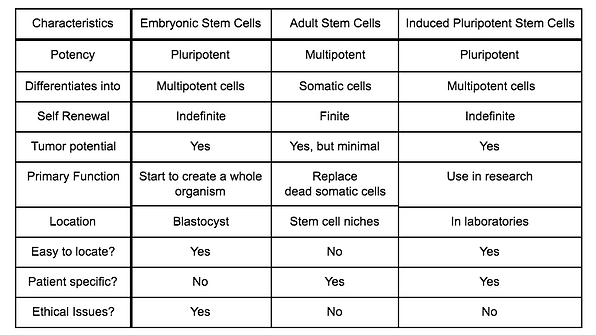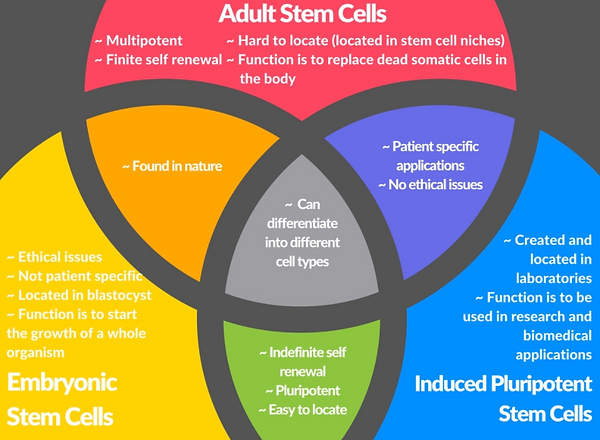STEM ED
In the previous lessons, we learned about the three major types of stem cells: Embryonic Stem Cells, Adult Stem Cells, and Induced Pluripotent Stem Cells. As a quick reminder, embryonic stem cells are cells that proliferate to form an embryo, which can then become a baby. Adult stem cells reside in the mature body and are there to proliferate and replace somatic cells that have died. Induced pluripotent stem cells (iPS cells) are cells that are created by scientists by combining somatic cells with transcription factors in a lab so that the resulting iPS cells have the potential to differentiate into any body cell. Let’s combine the concepts we have learned over the past few lessons to compare and contrast these 3 major types of stem cells.
One similarity between all the different types of stem cells is that they all have the ability to differentiate into multiple types of cells. However, the degree to which the stem cells can differentiate differs. Adult stem cells are multipotent, meaning they can become a few types of cells, while both embryonic and induced pluripotent stem cells are pluripotent, meaning they can become all types of cells. This means adult stem cells are more restricted in the type of cell they can differentiate into. Adult stem cells eventually differentiate into somatic cells, such as skin cells or neurons. Being pluripotent, embryonic and induced pluripotent stem cells differentiate into multipotent cells, such as adult stem cells, which will then eventually differentiate into somatic cells. Overall, ESCs, ASCs, and iPSCs will all eventually differentiate into somatic cells, but ESCs and iPSCs can become ANY type of cell, while ASCs can only become certain types. Another characteristic that makes all of these cells stem cells is their capability to self renew. However, embryonic and induced pluripotent stem cells have an indefinite capability to self renew while adult stem cells have a limited capability. Because adult stem cells eventually stop replacing cells in the body, organisms begin to experience the effects of aging. Self renewal is also why there is always the potential for tumor development in stem cell-based applications, even though the chance is minimized through the use of adult stem cells with their limited capability.
The three major types of stem cells differ considerably in their exact primary function and location. The primary function of embryonic stem cells is to initiate the development of an organism. Thus, they are created through fertilization when a sperm and an egg combine to begin the early stages of development. Embryonic stem cells are located in the inner cell mass of the blastocyst, which is what forms from the fusion of the sperm and the egg; the stem cells are easily isolated from the blastocyst on the 5th day of development for use in research. Adult stem cells are also found naturally in an organism, but they exist when the organism is matured. The primary function of adult stem cells is to proliferate and asymmetrically divide to replace dead somatic cells of all different types, from skin cells to blood cells. Thus, adult stem cells are located throughout the internal structure of the mature body in specialized microenvironments called stem cell niches, making them very difficult to locate for extraction for research. Unlike embryonic and adult stem cells, induced pluripotent stem cells are not found in nature. They are derived from somatic cells, which are easily isolated and reprogrammed into a pluripotent state through the use of transcription factors in laboratory conditions. Thus, their primary function is for use in research and biomedical applications.
Overall, embryonic and adult stem cells differ from iPS cells in that they have naturally derived origins and primary functions. But, when it comes time to locate stem cells for research, embryonic and iPS cells contrast from adult stem cells in that they are easier to locate. Two factors that concern research and applications of stem cells are the ability to be patient-specific and the potential problems caused by ethical issues. This is where adult and iPS cells contrast from embryonic stem cells, in that they both have origins that allow them to be patient-specific and ethically clean, while embryonic stem cells have an origin that faces ethical controversy.
Why do embryonic stem cells face ethical controversy? When the embryonic stem cells are isolated from the blastocyst, it destroys the capability of the blastocyst to develop into an embryo, a fetus, and eventually a fully functioning organism. Thus, it is highly controversial when human embryonic stem cells are isolated, since the destruction of a potential human embryo is closely linked with when people believe life begins. Some people believe that human life begins at conception, when the sperm combines with the egg to begin the process of development. According to this view, the embryo (in the form of a blastocyst) has interests and rights as a living being that must be respected, and thus it is unethical to isolate and use embryonic stem cells for research. However, there are others that view that the embryo is not fully living until it develops into a fetus later in development. Because early embryos do not meet this definition, people with this belief are not concerned with embryonic stem cells being used for research, as long as consent has been given by the woman or couple donating the embryo. Embryonic stem cell research has been regulated differently depending on the beliefs of different political parties and individuals. For example, President Bush placed limitations on federally funded embryonic stem cell research, only allowing the use of already established embryonic cell lines. In 2009, President Obama issued an executive order removing prior limitations on federally funded research using human embryonic stem cells and allowing the NIH to fund such responsibly conducted research. Use of embryonic stem cells in research still remains a point of controversy based on personal beliefs.
Stem Cell Types & Stem Cell Ethics
LEARN

